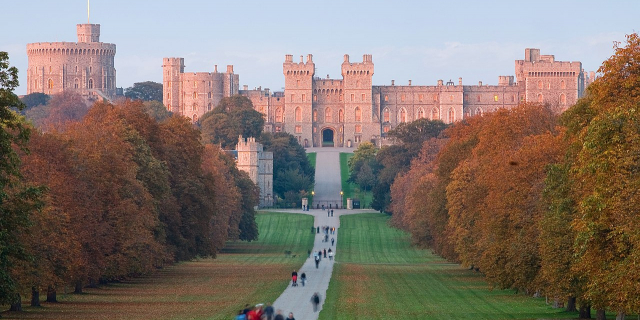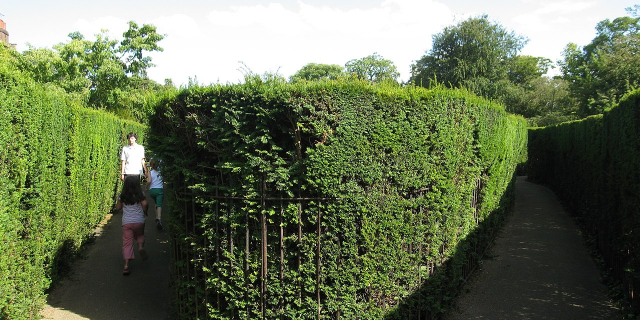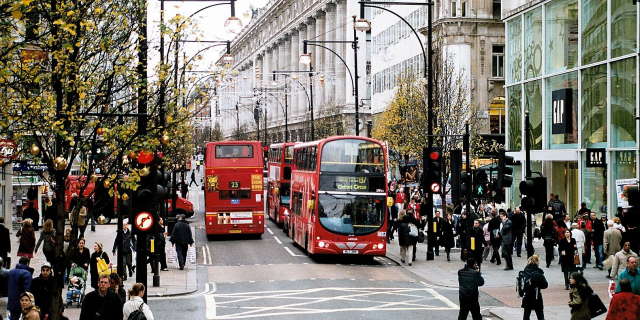Windsor Great Park
Windsor Great Park is a Royal Park of 2,020 hectares (5,000 acres), including a deer park, to the south of the town of Windsor on the border of Berkshire and Surrey in England. It is adjacent to the private 265 hectares (650 acres) Home Park, which is nearer the castle. The park was, for many centuries, the private hunting ground of Windsor Castle and dates primarily from the mid-13th century. Historically the park covered an area many times the current size known as Windsor Forest, Windsor Royal Park or its current name. The park is managed and funded by the Crown Estate, and is the only royal park not managed by The Royal Parks. Most parts of the park are open to the public, free of charge, from dawn to dusk, although there is a charge to enter Savill Garden.
Except for a brief period of privatisation by Oliver Cromwell to pay for the English Civil War, the area remained the personal property of the monarch until the reign...Read more
Windsor Great Park is a Royal Park of 2,020 hectares (5,000 acres), including a deer park, to the south of the town of Windsor on the border of Berkshire and Surrey in England. It is adjacent to the private 265 hectares (650 acres) Home Park, which is nearer the castle. The park was, for many centuries, the private hunting ground of Windsor Castle and dates primarily from the mid-13th century. Historically the park covered an area many times the current size known as Windsor Forest, Windsor Royal Park or its current name. The park is managed and funded by the Crown Estate, and is the only royal park not managed by The Royal Parks. Most parts of the park are open to the public, free of charge, from dawn to dusk, although there is a charge to enter Savill Garden.
Except for a brief period of privatisation by Oliver Cromwell to pay for the English Civil War, the area remained the personal property of the monarch until the reign of George III when control over all Crown lands was handed over to Parliament. The Park is owned and administered by the Crown Estate, a public body established by Act of Parliament in which the monarch and family members associated with its particular parts have non-executive, advisory roles. The Grade I listed park is on the Register of Historic Parks and Gardens. Windsor Forest and Great Park is a Site of Special Scientific Interest. Windsor Great Park is a nationally important site for fungi. Over 1,000 species have been found on the park's territory, including 43 species confined exclusively to Windsor. Several of Britain's rarest and most endangered species of fungi occur on the park's territory.
 Map of the Royal forests in Great Britain (1327–1336)
Map of the Royal forests in Great Britain (1327–1336)Windsor Castle was begun in the 11th century by William the Conqueror as it afforded a good defensive point over the River Thames. A vast area of Windsor Forest to the south of the castle became reserved by the King for personal hunting and also to supply the castle with wood, deer, boar and fish. It was not until later that it became necessary to formally define this area. In 1129, the first parker was appointed, and in 1240, King Henry III officially set out the borders of the "Park", a region many times larger than the current Great Park. The castle was a mere fortress at this time and, when hunting, King Henry would have been resident at the more comfortable manor house of Old Windsor (what later became known as Manor Lodge). The title "Parker" exists today as "Ranger of the Park", the current title-holder being Charles III. Kings Edward I and Edward III used the park for jousts and tournaments and the latter had his Royal stud there to supply horses for the Hundred Years' War. The moat at Bear's Rails contained the manor house of Wychamere, the home of William of Wykeham while he was building the castle. It was later used for bear-baiting.
DevelopmentBy the 18th century, the food value of the parkland to Windsor had decreased in importance and the new Hanoverian monarchs preferred to build on and garden the land rather than hunt in it. The Long Walk had been laid out by King Charles II and the planting of its trees completed by William of Orange in the 1680s, with double rows of elms which lasted until World War II, but the Georges extended it and built numerous features and monuments, such as the Copper Horse (depicting George III) and the Obelisk (in honour of William, Duke of Cumberland). George III had a set of 2,000-year-old Roman ruins imported from Libya and placed in the park.
Virginia Water was begun in 1746 by William, Duke of Cumberland who was then Ranger of the Park. Few details are recorded of the building of the lake; however it has been suggested that prisoners of war from the recent Jacobite risings, who were encamped at the nearby Breakheart hill, were involved. The original lake was much smaller than the current form, and was destroyed in a flood in 1768. In 1780, Paul and Thomas Sandby began construction of a much larger lake at the site, and went on to add an artificial waterfall, Meadow Pond and Obelisk Pond. The lake replaced a small stream of the same name which was probably named after Queen Elizabeth I, who was known as the "Virgin Queen".
Victorian expansion Queen Elizabeth II and Ronald Reagan riding on horseback in the grounds of Windsor Great Park during President Reagan's 1982 official visit to the United Kingdom.
Queen Elizabeth II and Ronald Reagan riding on horseback in the grounds of Windsor Great Park during President Reagan's 1982 official visit to the United Kingdom.Queen Victoria created the park that still exists. The Windsor Castle Act 1848 was implemented to reform land use and rights around Windsor Castle. This led to the removal of existing roads and the creation of new ones to redirect people away Home Park. The changes were the result of the death of Prince Albert, when Queen Victoria largely withdrew from public life. At Frogmore she built a Royal Mausoleum for Albert. She was later buried there upon her own death, along with a number of other subsequent members of the royal family.
During the 19th and early 20th century, one of the main events for farmers near and far was the Christmas sale of stock from the Royal Windsor Estates. Held on the same week as the Smithfield Show, buyers came from all over the country to buy something from the monarch. The sale in 1850 was held on 17 December by Messrs Buckland & Sons of Windsor. It included Superior Fat Heifers for £20 each; 10 fat ewes, fed by Prince Albert, for 33/10; Fine Old Wether Sheep, fed by His Grace the Duke of Buccleuch, for 40/6. The sale made a total of £226.[1] On 12 December 1894, Messrs Buckland & Sons were proud to announce:
The Prince Consort's Flemish Farm
A Xmas sale of fat stock belonging to HM the Queen
ON WEDNESDAY, DECEMBER 12, 1894
At One o'Clock precisely
Carriages will meet the Trains at both Windsor Stations[2]
The Smith's Lawn area of the Park began to be used for flying in the 1920s, an activity which continued in various forms until the early 1950s. Improvements were made to the grass landing area in the mid 1930s, when it was used by the Prince of Wales (later Edward VIII). He operated several different types of aircraft from here, including several types of de Havilland airplanes, ranging from Moths to Dragon Rapides.
On 29 April 1931, Gordon Olley landed a large (for the time) twin-engine Imperial Airways airliner, the Armstrong Whitworth Argosy ("City of Glasgow"), at Smith's Lawn.[3]
In 2016, the Duke of Edinburgh unveiled a memorial at Smith's Lawn to its use as an airfield. He himself had made his first solo flight from there in 1952, after regular use of the site as an airfield had ceased.[4]
Second World WarDuring the war, aviation related activities included a factory dispersal site (to minimize the risk of Luftwaffe bombing) for Vickers-Armstrongs, who built and maintained Wellington bombers here. Other wartime aviation activities included use as a Relief Landing Ground for de Havilland Tiger Moth trainers at nearby No. 18 Elementary Flying Training School at Fairoaks.[5]
The Smith's Lawn area of the Park was also used for housing troops. During the 1940s, much of the deer park was ploughed and farmed for food, which involved the felling of hundreds of ancient trees. Over 200 large bombs fell on the land, including several V-2 rockets. During the 1948 Summer Olympics, the park was used as the road cycling venue.[6] In the 1950s, the Park was gradually turned into the recreation area open to the public that it is today. This involved the re-planting of Savill Gardens (which had been allowed to run wild during the war) and the new Valley Gardens. In 1951, a large wall for creeping plants was built at Savill using bricks from bombed-out London buildings. In 1958, a Totem pole was installed nearby, a gift from British Columbia to the Queen.
ProtestsIn 1972 the Irish anarchist Ubi Dwyer organised the "People's Free Festival", the first of the Windsor Free Festivals in the Park, attended by 700 people. A co-organiser Sid Rawle claimed that Windsor Great Park has been common land until the 18th century, and illegally inclosed (made private) by George III. Prince Philip, Duke of Edinburgh was reported to be "furious". Ubi and his allies repeated the festival in 1973 with at least 1,400 in attendance. In 1973, the Windsor Great Park regulations were introduced. In 1974, 7,000 people turned up but it was violently broken up by police, who made 220 arrests, and the festival was banned. Dwyer was jailed the next year for distributing leaflets to promote another festival and Rawle was given three months for reproducing parts of Ubi's leaflets in the underground newspaper International Times.[7]



































Add new comment